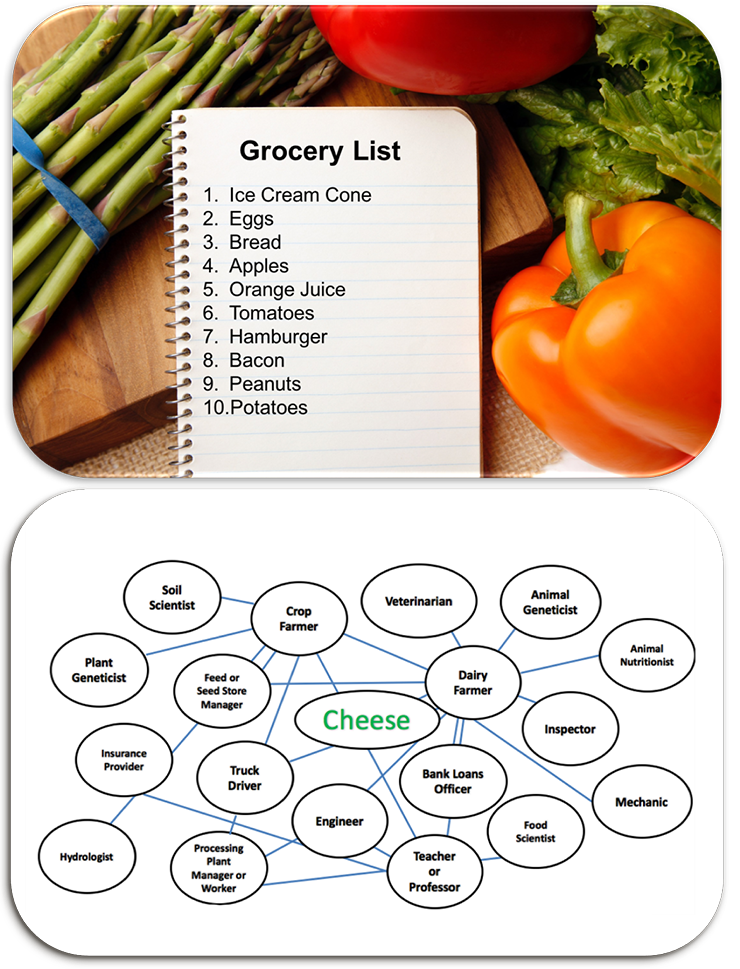 Relevancy and Engagement
agclassroom.org/la/
Relevancy and Engagement
agclassroom.org/la/
Lesson Plan
Journey 2050 Lesson 6: Careers (Grades 6-8)
Grade Level
Purpose
Students will explore careers related to agriculture, identify personal interests within agriculture or a related field and discuss how agricultural professionals can impact world food. Grades 6-8
Estimated Time
Materials Needed
- Career slide deck
- Large piece of poster paper, 1 per group
- Markers, 1–2 per group
- Career Game Level 6
- Play online or download app
- Create Free Teacher Account to track student progress and print reports.
Vocabulary
agriculture: the science or practice of farming, including cultivation of the soil for the growing of crops and the rearing of animals to provide food, wool, and other products
career: an occupation undertaken for a significant period of a person's life and with opportunities for progress; generally a profession requiring special training
sustainable agriculture: an approach to agriculture that focuses on producing food while improving the economic viability of farms, protecting natural resources, and enhancing quality of life for farmers and society as a whole
Did You Know?
- Farmers and ranchers represent 2 percent of the population in North America.2
- In 2014, 17.3 million jobs were related to agriculture in the United States. This accounts for 9.3 percent of all U.S. employment and includes jobs outside of the farm.1
- Canada is the 5th largest agricultural exporter in the world, and the agriculture and agri-food industry employs 2.2 million Canadians (that's 1 in 8 jobs).2
- On average, women comprise just over 40 percent of the agricultural labor force in the developing world (statistics vary by country but women make up almost 50 percent in Africa3).
Background Agricultural Connections
Journey 2050 takes students on a virtual simulation that explores world food sustainability and answers the question, "How will we sustainably feed nearly 10 billion people by the year 2050?" The lesson plans and online simulation program allows students to make decisions on a virtual farm and witness their impact on society, the environment, and the economy at a local and global scale. The lessons engage students with the important concepts regarding sustainable agriculture. The online simulation contextualizes these concepts as students experience the lives of real farm families throughout the world. As students interact with each family, they learn the role of best management practices in feeding the world, reducing environmental impacts and improving social performance through greater access to education, medical care and community infrastructure. These lessons can be taught individually or as an entire unit. See the links below for the remaining lessons: ![]()
- Lesson 1: Sustainable Agriculture
- Lesson 2: Soil Nutrients
- Lesson 3: Water
- Lesson 4: Economies
- Lesson 5: Land Use
- Lesson 6: Careers
- Lesson 7: Technology and Innovations
- Take Action: Project-based Learning and Program Summary
With 1.3 billion people are employed in the sector, agriculture is the second greatest source of employment worldwide after services and it accounts for 28% of global employment.1 The agricultural industry varies widely from country to country. In North America, farmers and ranchers represent 2 percent of the population.2 Technological and scientific advancements have increased the efficiency of food production in developed countries, meaning fewer workers are required to grow food and raise livestock. In contrast, developing countries employ up to 50 percent of the population in farming. Very poor nations employ even more.
The story of agriculture is bigger than just farming. There’s a vast network of interconnected jobs, people and industries working together to make agriculture successful. Each of these jobs is integral to building a sustainable world. For every farmer who grows crops and raises livestock there are numerous others working in careers connected to the production of food and fiber that sustain our world. The expansive web of agricultural jobs includes careers related to sales and services, engineering, mechanics, communications, marketing, economics, education, agronomy, soil science, animal science, government relations, food science, food processing and packaging, transportation and more.
Engage
This lesson has been adapted for online instruction and can be found on the Journey 2050 eLearning site.
- Display the Career slide deck on the board.
- Divide your students into groups of two to three. Give each group a piece of poster paper and some markers.
- Slide 2: Assign each group one food item from the grocery list.
- Inform the students that they will have five minutes to brainstorm all the careers that played a role in producing their assigned food item. Instruct students to draw a career web on their sheet of paper. Their food item should be in the middle, and each career they think of will be connected to create a concept map. (See example on slide 2.)
- Start a five-minute countdown timer and allow students to go to work.
- After five minutes is up, have each group count how many careers they came up with.
- Have each group share their web with the class. (If time is limited, only ask the group with the most careers to share their web with the class.) Discuss with students that there are many careers that play a hand in providing our food supply. Some careers work directly on the farm, but many other jobs related to agriculture do not.

Explore and Explain
 Preparation: Prior to class, review the Background information, and slide deck associated with the lesson. Review the Teacher's Guide: Getting Started document for further information to prepare for class.
Preparation: Prior to class, review the Background information, and slide deck associated with the lesson. Review the Teacher's Guide: Getting Started document for further information to prepare for class.
Activity 1: Careers in Agriculture
- Display slide 3 of the Career slide deck on the board.
- Ask students the following series of questions.
- What is the primary ingredient of cheese? (milk)
- What kind of farm is milk produced on? (dairy farm)
- Beginning on a dairy farm where the milk is produced and ending at your home where cheese is consumed, how many careers played a role in providing cheese for our diet? (allow students time to begin thinking about the answer to this question.)
- Slide 3: Display the cheese career web. Explain that there is an interconnected web of careers that depend upon each other to produce the food we eat. Using the notes below, briefly describe how these careers are connected to the dairy farm and are necessary to produce the milk that is used to make cheese. Be sure to also explain that the web could be much larger. This is only a small sample.
- Dairy Farmers: Raise and care for cattle on farms where milk is produced.
- Veterinarians: Assist farmers in maintaining the health and well-being of animals.
- Animal Geneticists: Research how genetic traits impact the health and productivity of animals and help farmers make the best decisions regarding the genetics and breeding of their animals.
- Animal Nutritionists: Formulate the diets of animals to meet their nutritional needs. Nutritionists help dairy farmers provide a healthy diet for their cattle at each stage of their life.
- Inspectors: Monitor the transportation of livestock animals and verify livestock ownership.
- Salesmen: Help in many areas of agriculture by providing the right kinds of tools and equipment to accomplish a variety of jobs.
- Crop Farmers: Produce feed for dairy farmers, such as corn, alfalfa, soybeans, etc.
- Soil Scientists/Agronomists: Analyze the quality of soil and help farmers balance the nutrients to enable the growth of healthy crops.
- Plant Geneticists: Study the genetic traits of plants and use methods of crossbreeding and hybridization to perpetuate desirable traits in plants.
- Feed or Seed Store Managers: Provide farmers with access to the feed, seeds and other farm supplies necessary to their farms.
- Truck Drivers: Transport agricultural goods from production to processing and then to be distributed to consumers.
- Engineers: Design new technology to improve productivity and sustainability (for example, automated sprinkler systems, robotic milking equipment, etc.).
- Food Scientists: Study the science of food preparation and formulate recipes (for example, developing different types of cheese making methods).
- Mechanics: Repair and maintain equipment such as trucks, tractors and farming implements.

 Slide 4: Open the Career Game Level 6 on each student’s computer or device. Explain the following:
Slide 4: Open the Career Game Level 6 on each student’s computer or device. Explain the following:
- In this level, you will create an avatar and answer questions based on your personal interests, favorite subjects in school, work environment preferences, etc.
- Once the information is entered, the program will generate an agricultural career that relates to your interests. This career is just one example of many options that you may be interested in.
- Once you are given a career, open the career profile and read about it. Keep in mind that all the people profiled in the game are real people who work in agriculture. Next, write your own response within the game to describe what your career involves and how it helps feed the world.
- After students have finished the game, have them tell you about the different careers they chose. Be sure to ask them how their careers relate to agriculture, sustainability and feeding the world. Continue asking about different careers until no more are left, or as time permits.
- Slide 5: Ask students, “Did you know that less than two percent of North American’s farm?” (To give a frame of reference, explain that in the early 1900s it was 38 percent.1) Yet, in developing countries like Kenya the majority of the population (75% work in agriculture) works directly in producing Explain, “Even though less than two percent of North Americans farm, 9.3 percent2 (1 in 11) of Americans and 12.5 percent (1 in 8) of Canadians work in a field related to agriculture. Careers in agriculture spread from farm to fork and beyond.
| Throughout the Journey 2050 lessons students have begun to understand the impact and environmental strain of a growing population. It's important for students to understand the need for skilled agricultural professionals to discover and use best practices to reach optimum human sustainability. |
Elaborate
-
View the video Your Life - Your Agriculture (4:23 min), produced by Canada Agriculture in the Classroom.
-
Utilize the National FFA Ag Explorer website to show a variety of careers and break down the salary, education, job description and much more.
-
Refer students to the Careers in Agriculture YouTube playlist. Ask students to choose three careers they might enjoy and watch the associated videos.
-
Interview someone in an agricultural career.
-
Watch the Where in the World (4:39 min) video, and discuss how culture impacts the demand for jobs in agriculture.
-
Meet the Bug Chicks by watching the three-minute video clip You’re Hired! (3:59 min). Students will be introduced to several careers and jobs in the industry of agriculture through live footage of a variety of individuals busy at work.
-
The Journey 2050 lessons provide an introduction to agricultural sustainability. Take a deeper dive into additional sustainability topics using the links found on the Sustainability page.
Evaluate
Review and summarize with the following key points (Slide 7):
- Many diverse careers are found in agriculture.
- People working in agriculture play a hand in feeding the world sustainably.
- Off-farm agricultural careers are important and integral to sustainability. The people in these careers do many things such as:
- Improve efficiency in food production.
- Discover and help implement new best management practices to be used in agriculture.
- Educate and communicate to the public about the source of our food.
- Help minimize food waste and hunger.
Sources
- https://www.agrivi.com/blog/employment-in-agriculture/
- http://www.fb.org/newsroom/fast-facts
- https://www.ers.usda.gov/data-products/chart-gallery/gallery/chart-detail/?chartId=58282
- https://www.agr.gc.ca/resources/prod/doc/info/pdf/aafc-aac_brochure_mar2013_eng.pdf
- http://www.fao.org/docrep/013/am307e/am307e00.pdf
- https://growinganation.org/
- https://www.ers.usda.gov/data-products/ag-and-food-statistics-charting-the-essentials/ag-and-food-sectors-and-the-economy.aspx
Acknowledgements
The Journey 2050 program was originally developed by Nutrien in collaboration with Calgary Stampede, Alberta Canola Producers Commission, Nutrients for Life Foundation, and Agriculture in the Classroom Canada. Authors and contributors were drawn from each of these organizations under the direction of Lindsey Verhaeghe (Nutrien) and Robyn Kurbel (Calgary Stampede.) The lessons were updated and revised in 2017 and 2022 with contributions from the original J2050 Steering Committee, the National Center for Agricultural Literacy, and the National Agriculture in the Classroom Organization.
Recommended Companion Resources
- Ag & Food Careers
- Agricultural Engineering Video
- Agriculture and the Sustainable Development Goals
- Agronomy – Grow with It!
- An Agricultural Interview
- Career Profile Video: Educator & Agronomist
- Careers 101 e-Magazine
- Careers Ag Mag
- Careers for Green Thumbs
- Careers in Agriculture
- Careers in Agriculture Videos
- Crop Science Career Profiles
- Discover Agriculture Careers (Website)
- Employment Opportunities for College Graduates in Food, Renewable Energy, and the Environment
- Field to Film Career Snapshots
- Growing Today for Tomorrow
- Journey 2050 Program Summary: Project-Based Learning
- Living Science Career Cards (posters or mini-posters)
- National FFA AgExplorer
- Pathful Connect
- Seed Your Future
- Serious Cereal Science Kit